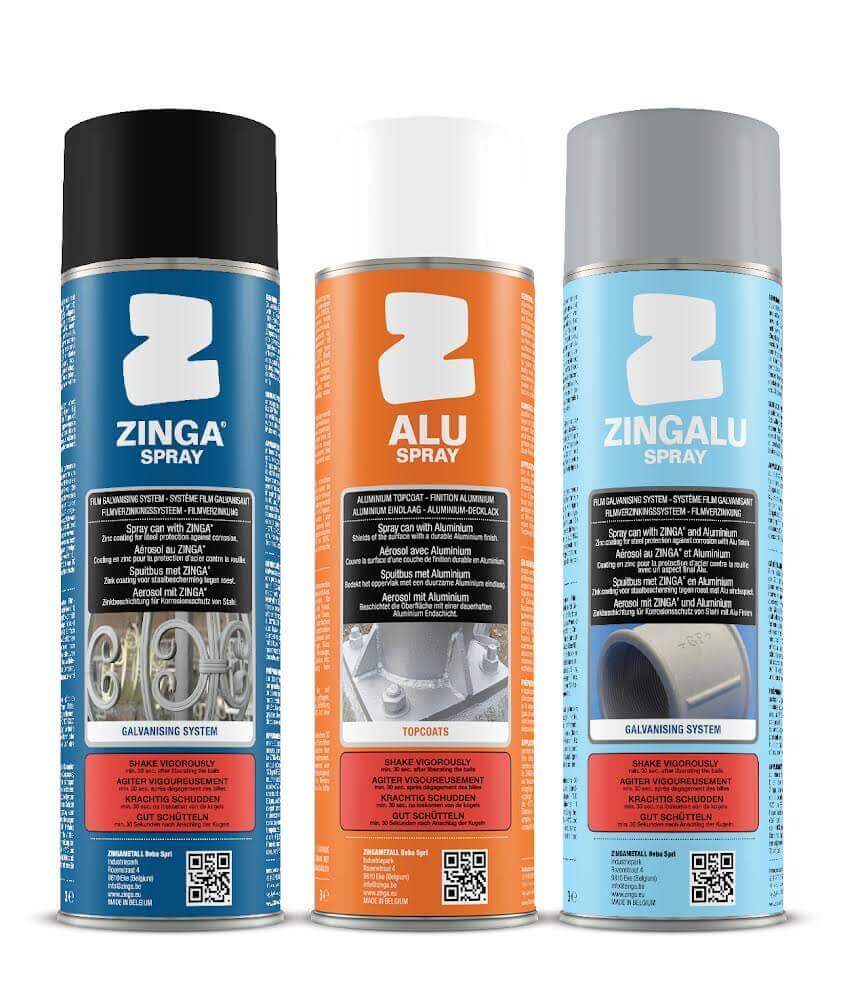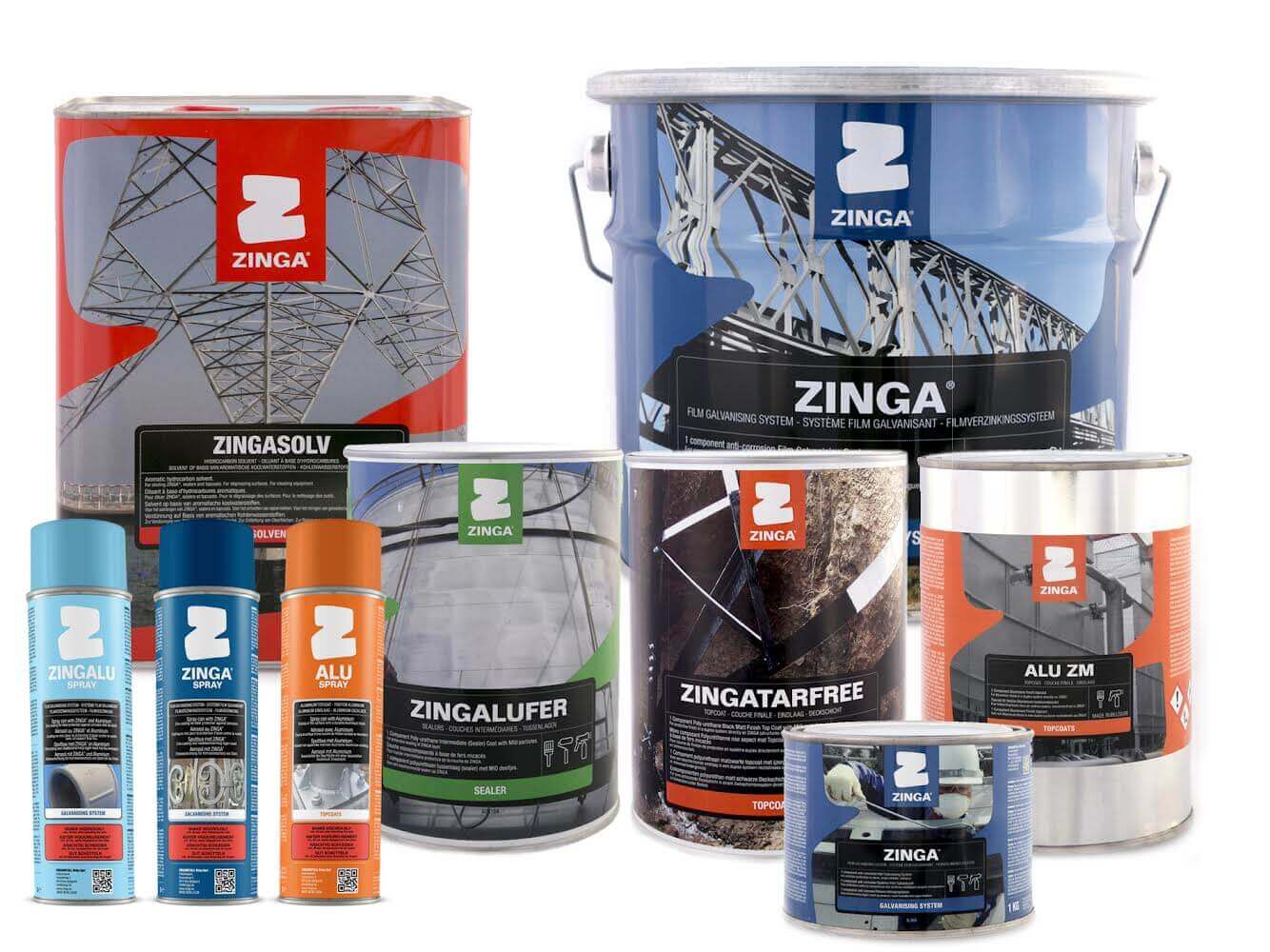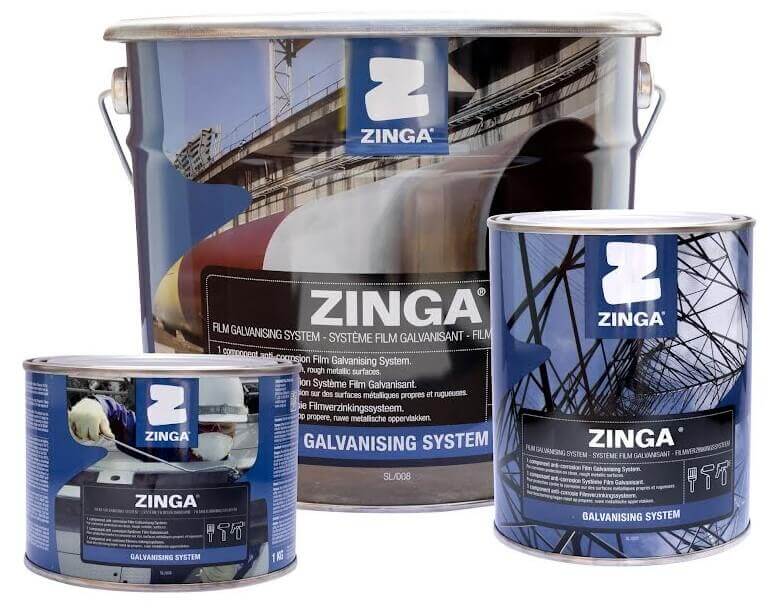Comparison of Zinga's security system in general with other systems
There are five important types of zinc coating
جلفنة الغمس الساخن “Hot-dip galvanizing”
يعتبر طلء جيد جدا – متين جدا عيوبه ما يلي
- فقط 20% من طبقة الحماية تشتمل على الزنك النقي. ما تبقى هو سبائك الحديد والزنك والتي تبدأ في الصدأ بعد استنفاذ طبقة الـ 20% من الزنك.
- طبقة الحماية هشة جدا ويمكن أن تتكسر وتتقشر تحت الضغوط الميكانيكية والثني او الانحناء.
- لا يمكن تجديد طبقة الجلفنة في الموقع بمعنى آخر أن العناصر المجلفنة للمنشأة يجب أن تفك وتعاد للمصنع لجلفنتها من جديد.


الزنك غير العضوي “Inorganic Zinc”
هو طلاء جيد يتكون من رقائق الزنك مختلطة مع مثبت/ناقل“carrier/binder” تشكل طلاء يشبه كثيرا الصخر الزيتي او الطيني وهذا الطلاء يوفر حماية كهربائية “galvanic protection” . عيوبه ما يلي
- يتكون من جزئين من الطلاء.
- قدرة الترابط بين جسيماته ضعيفة.
- هش ويكسر بسهولة تحت الضغط.
- لا يمكن بناء اكثر من طبقة دون الحاجة الى طبقة وسيطة لمقاومة اجهادات القص ولذلك فإن طبقة الزنك غير العضوية سوف تستنزف بسرعة.
الزنك العضوي التقليدي “Conventional organic zinc”
إلى حد ما يعتبر برايمر جيد. وهو يتكون من حبيبات الزنك المختلطة في مثبت/ناقل “carrier/binder” . عيوبه ما يلي:
- عادة ما يكون محتوى الزنك فيها أقل من 80% وبالتالي لايمكن أن توفر حماية كاثودية (على الاقل 92% مطلوبة)
- لايمكن أن يبنى دون التسبب في تكسير الطين.
- يعطي قوة ترابط ضعفة مع طبقة الطلاء العلوية.
- هش وبالتالي سوف لن يتحمل الضغوط الميكانيكية.
- DFSDFS D

Thermal galvanizing with zinc.
| # | Zinga | thermal spray |
|---|---|---|
| the cost | Cheaper | very expensive |
| bonding power | The bonds are electrical and mechanical and will not easily loosen from the surface of the metal when bent and heated. | The bonds are mechanical, and they are brittle and can crack and flake. |
| Application | You can easily apply a topcoat if necessary without further surface preparation | You need a special type of primer before applying a top coat |
| Subsequent applications | Its layer can be renewed even after several years by simply washing the surface with high pressure water from zinc salts and then re-coating with Zinga. The new layer will blend in with the old layer of Zynga. | Too expensive to repaint |
| life expectancy | Zinga has a known consumption rate according to the surrounding environment (3-5 microns annually), and therefore it is possible to anticipate and develop an appropriate periodic maintenance program according to the type of facility and its life span. | nothing |
Conclusion
Zinga combines the advantages of the first three methods without the disadvantages
- Zinc is 96% in all Zinga layers from top to bottom.
- They are mechanically, electrically and chemically interconnected.
- It will withstand high mechanical stress and without cracks or disintegration of bonds.
- It will withstand bending up to 180 degrees without loosening.
- Each new layer of Zinga mixes and dissolves in the previous one to form one unique, integrated layer.
- Zinga can be renewed no matter how long it takes and anywhere, by simply washing with fresh pressurized water and applying a new layer. This new layer will mix and dissolve with the old previous layer.
- Zinga has a known consumption rate according to the surrounding environment (3-5 microns annually), and therefore it is possible to anticipate and develop an appropriate periodic maintenance program according to the type of facility and its life span.
- Zynga can be easily applied on site.
General comparison
| Features | Zinga | galvanization | paint |
|---|---|---|---|
| Active or cathodic protection | |||
| It is compatible with the new layer of the same material | |||
| accepts another layer | |||
| For application under extreme conditions of high & low temperatures and in humid environments, in high and low temperatures and in humid environments | |||
| Unlimited period of use | |||
| .comparisons.comparison_table_25 | |||
| Flexible, self-adjusting coating. Resistant to temperature variations and mechanical shocks. | |||
| weldable |